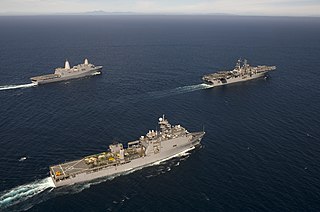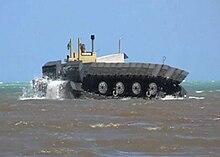
The Wasp class is a class of landing helicopter dock (LHD) amphibious assault ships operated by the United States Navy. Based on the Tarawa class, with modifications to operate more advanced aircraft and landing craft, the Wasp class is capable of transporting almost the full strength of a United States Marine Corps Marine Expeditionary Unit (MEU), and landing them in hostile territory via landing craft or helicopters as well as providing air support via AV-8B Harrier II attack aircraft or F-35B Lightning II stealth strike-fighters. All Wasp-class ships were built by Ingalls Shipbuilding, at Pascagoula, Mississippi, with the lead ship, USS Wasp, commissioned on 29 July 1989. Eight Wasp-class ships were built, and as of April 2021, seven are in active service, as USS Bonhomme Richard was seriously damaged by fire on 12 July 2020, and subsequently decommissioned in April 2021.

Landing craft are small and medium seagoing watercraft, such as boats and barges, used to convey a landing force from the sea to the shore during an amphibious assault. The term excludes landing ships, which are larger. Production of landing craft peaked during World War II, with a significant number of different designs produced in large quantities by the United Kingdom and United States.

Amphibious warfare is a type of offensive military operation that today uses naval ships to project ground and air power onto a hostile or potentially hostile shore at a designated landing beach. Through history the operations were conducted using ship's boats as the primary method of delivering troops to shore. Since the Gallipoli Campaign, specialised watercraft were increasingly designed for landing troops, material and vehicles, including by landing craft and for insertion of commandos, by fast patrol boats, zodiacs and from mini-submersibles. The term amphibious first emerged in the United Kingdom and the United States during the 1930s with introduction of vehicles such as Vickers-Carden-Loyd Light Amphibious Tank or the Landing Vehicle Tracked.

The Landing Craft Air Cushion (LCAC) is a class of air-cushioned landing craft (hovercraft) used by the United States Navy and the Japan Maritime Self-Defense Force (JMSDF). They transport weapons systems, equipment, cargo and personnel from ship to shore and across the beach. It is to be replaced in US service by the Ship-to-Shore Connector (SSC).

USS Rushmore (LSD-47) is a Whidbey Island-class dock landing ship of the United States Navy. She was the second navy ship to be named for the Mount Rushmore National Memorial in the Black Hills of South Dakota. She is the seventh ship in her class of dock landing ships and the fourth ship in that class to serve in the United States Pacific Fleet.

USS Frederick (LST-1184) was a Newport-class tank landing ship which replaced the traditional bow door-design tank landing ships (LSTs) of the United States Navy. The ship was named after the city of Frederick, Maryland and Frederick County, Maryland. The vessel entered service in 1970 with the United States Pacific Fleet and saw service during the Vietnam War, and the Persian Gulf War earning three battle stars. The ship was decommissioned in 2002 and put up for sale.

A surface effect ship (SES) or sidewall hovercraft is a watercraft that has both an air cushion, like a hovercraft, and twin hulls, like a catamaran. When the air cushion is in use, a small portion of the twin hulls remains in the water. When the air cushion is turned off ("off-cushion" or "hull borne"), the full weight of the vessel is supported by the buoyancy of the twin hulls.

Newport-class tank landing ships were an improved class of tank landing ship (LST) designed for and employed by the United States Navy from 1969 to 2002. The ships were intended to provide substantial advantages over their World War II-era predecessors. Larger and faster than any previous LST design, they carried a ramp over the bow that allowed them to surpass 20 knots, a goal of the United States amphibious forces. 27 were planned of which twenty were completed, the high number due to the demands of US force projection estimates. However, the arrival of the air-cushioned landing craft which allowed for over-the-horizon attacks made the class obsolete in the eyes of the United States Navy. Placed in reserve, twelve were eventually sold to foreign navies, while the remaining eight have since been decommissioned.

The Dokdo-class amphibious assault ship is a class of landing platform helicopter (LPH) and amphibious assault ships operated by the Republic of Korea Navy (ROKN). It was designed and built by Hanjin Heavy Industries (HHIC), and were meant to enhance South Korea's amphibious operation capability in terms of assault and military operations other than war (MOOTW).

USS Peoria (LST-1183) was a Newport-class tank landing ship which replaced the traditional bow door-design tank landing ships (LSTs). The vessel took part in the Vietnam War and Gulf War. The ship was constructed by the National Steel and Shipbuilding Company in San Diego, California and was launched in 1968 and commissioned in 1970. Named for a city in Illinois, Peoria was assigned to the United States Pacific Fleet and home ported at San Diego. The tank landing ship alternated between military exercises along the United States west coast and deployments to the western Pacific. Peoria took part in the evacuations of Phnom Penh, Cambodia and Saigon, South Vietnam, both of which signaled the end of American involvement in the respective countries. The vessel was decommissioned 1994 and sunk as a target ship during a RIMPAC naval exercise in 2004.

The Zubr class, Soviet designation Project 1232.2, is a class of Soviet-designed air-cushioned landing craft (LCAC). The name "Zubr" is Russian for the European bison. This class of military hovercraft is, as of 2023 the world's largest hovercraft, with a standard full load displacement of 555 tons. The hovercraft was designed to sealift amphibious assault units from equipped/non-equipped vessels to non-equipped shores, as well as to transport and plant naval mines.

An amphibious warfare ship is an amphibious vehicle warship employed to land and support ground forces, such as marines, on enemy territory during an amphibious assault.

The Engin de débarquement amphibie rapide (EDA-R) is a class of French roll-on/roll-off catamaran landing craft (L-CAT) operated by the French and Egyptian navies. They transport vehicles, cargo and personnel from Mistral-class amphibious assault ships to shore.

The Aerial Reconfigurable Embedded System (ARES) was a concept for an unmanned VTOL flight module that can transport various payloads. The concept started as the TX (Transformer) in 2009 for a terrain-independent transportation system centered on a ground vehicle that could be configured into a VTOL air vehicle and carry four troops. ARES' primary function was the same as TX, to use flight to avoid ground-based transportation threats like ambushes and IEDs for units that don't have helicopters for those missions. It was to be powered by twin tilting ducted fans and have its own power system, fuel, digital flight controls, and remote command-and-control interfaces. The flight module would have different detachable mission modules for specific purposes including cargo delivery, CASEVAC, and ISR. Up to 3,000 lb (1,400 kg) of payload would be carried by a module.
The Type 724 Landing Craft Air-Cushion (LCAC) is the first indigenous air cushion landing craft in operational use with People's Liberation Army Navy (PLAN), and it origin dates all the way back in the early 1960s, when 7th Academy was assigned to lead the developmental work on air cushioned vehicles for a 10-year plan lasting from 1963 to 1972. Two projects developed from this research work, and Type 724 LCAC is the direct descendant of these two research projects.

The Ship-to-Shore Connector (SSC), also known as the LCAC 100 class, is a system proposed by the United States Navy as a replacement for the Landing Craft Air Cushion (LCAC). It will offer an increased capacity to cope with the growing weight of equipment used by the United States Army and Marine Corps. As of 2015, the program is forecast to cost a total of US$4.054B for 73 hovercraft.

The Amphibious Combat Vehicle (ACV) is a program initiated by Marine Corps Systems Command to procure an amphibious assault vehicle for the United States Marine Corps to supplement and ultimately replace the aging Assault Amphibious Vehicle (AAV). The program replaces the Expeditionary Fighting Vehicle (EFV) program canceled in 2011. Originally a plan to develop a high-water-speed vehicle, the program has expanded into a multi-phased approach to procure and develop several types of amphibious-capable vehicles to address near and long-term requirements.

The Solgae-class LCAC, often called Solgae 631 class after the name of lead ship, is an air-cushioned landing craft (LCAC) designed for the Republic of Korea Navy. Built by Hanjin Heavy Industries, they're designed to operate from the ROKS Dokdo and the future Dokdo-class amphibious assault ships. This project was known as the LSF-II or Landing Ship Fast - II during development.

The Landing Craft Air Cushion (Light), or LCAC(L), is a small amphibious hovercraft able to transverse both land and water. Like all amphibious landing craft in the Royal Navy, they are operated by the Royal Marines to transport troops or equipment from ship to shore during an amphibious landing.



















